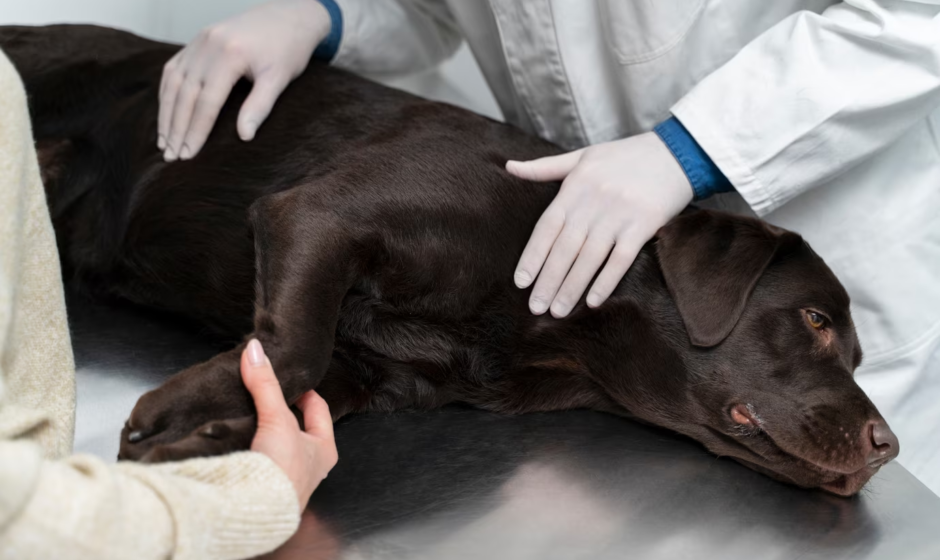Introduction
Cushing’s disease, a perplexing and multifaceted disorder, casts its shadow over the lives of numerous dogs, especially those in their golden years. This enigmatic ailment stems from an unwarranted surplus of cortisol, an intricate hormone woven by the adrenal glands. An array of manifestations accompanies Cushing’s disease in dogs, encompassing an unquenchable thirst, a surge in appetite, alopecia, and a protruding abdomen. Yet, amidst this riddle, a glimmer of hope emerges, for through judicious veterinary care and deft management, dogs can navigate the labyrinthine corridors of Cushing’s disease with triumph. This article endeavors to unravel the intricacies of Cushings disease dogs, unearthing its common signs and symptoms, and illuminating the path to diagnosis and treatment.
Manifestations of Cushing’s Disease in Dogs
A complex tapestry of symptoms unfolds when Cushing’s disease infiltrates the lives of our beloved canine companions, colloquially known as man’s best friend. Amidst the intriguing panorama of perplexity, one encounters the hallmark sign—excessive drinking and urination, a perplexing consequence of elevated cortisol levels beckoning dogs towards an unending quest for hydration. In the labyrinth of symptoms, a potpourri of manifestations intermingles, including the bulging appearance caused by an engorged liver or adrenal gland, a cascade of hair loss beginning at the flanks and scaling the canine’s back, a disquieting restlessness coupled with excessive panting, and the recurring torment of skin infections. Even in the throes of hunger, these dogs partake in a paradoxical feast, their voracious appetites in defiance of regular mealtimes. The frailty of their skin, susceptible to easy bruising, serves as yet another enigmatic facet of this bewildering ailment.
Unraveling the Causes of Cushing’s Disease in Dogs
Cushings disease dogs, akin to a labyrinthine enigma, lies at the crossroads where the canine body grapples with an abundance of cortisol, a conundrum more commonly encountered in humans but, intriguingly, finds greater favor with our loyal canine companions. The epicenter of bewilderment lies in discovering the causal threads of this ailment and devising means to tame its unruly tempest. When contemplating the source of this ailment, the eyes of inquiry gaze upon the possibility of an adrenal or pituitary gland tumor as the chief architect behind this hormonal havoc. Mercifully, these tumors tend to favor a benign disposition, yet their unchecked growth can render them mischievously malevolent. In rarer realms, other diseases, like hypothyroidism or acromegaly, venture to share the stage with Cushing’s disease, accentuating the conundrum of causality.
Diagnosis and Treatment: A Journey Through the Maze
The expedition to diagnose and treat Cushing’s disease in dogs embarks upon an enthralling odyssey, marked by the pursuit of knowledge and the mastery of tests that beseech the truth to unravel. This labyrinthine journey takes form through a careful evaluation of physical evidence and intricate blood work. Behold the ACTH stimulation test and the low-dose dexamethasone suppression test, veritable guides that illuminate the labyrinth’s twists and turns, revealing cortisol’s cunning manipulations. Alas, further exploration may beckon, with urine tests measuring creatinine concentrations or liver enzyme activity tests seeking the elusive ratio of ALT/AST. The triumphant revelation of diagnosis paves the way for diverse treatment paths, each navigating a separate passage in the labyrinthine anatomy of treatment options. Medication therapy, the artful blocking of cortisol production in adrenal glands with trilostane, stands as one beacon of hope. Another passage leads to surgery, the art of adrenalectomy, wherein the offending glands are spirited away to restore harmony to the canine’s corporeal realm.
The Quest for Prevention: A Battle Against the Unseen Foe
Preventing Cushing’s disease, the quest for which few dare to embark upon, requires a resilient spirit and keen foresight. The elusiveness of cure forces one to retreat to the realm of prevention, where vigilance and prudence stand as steadfast allies. A sentinel of health, the veterinarian, becomes an integral part of this odyssey, leading the charge with regular check-ups that pry into the secrets of the canine physique, unveiling early signs of the enigmatic affliction. In this preventive pursuit, lifestyle metamorphoses emerge as formidable weapons. With a flourish of their pen, veterinarians inscribe prescriptions for exercise, a balm for the soul and a shield against the disease’s encroachment. A delectable diet, thoughtfully curated, takes center stage, striking a chord with canine taste buds while safeguarding against the unseen foe’s advances. Yet, in the grand tapestry of protection, the invisible nemesis of environmental stressors, like symphonies of noise or capricious climatic extremes, warrants heedful guardianship.
Conclusion
In the twilight of this odyssey through the labyrinthine realm of Cushing’s disease in dogs, one thing becomes strikingly clear—this is no mere malady but a formidable adversary that demands respect and diligence. The path to victory lies in deciphering the enigma’s complexities and embracing the trinity of diagnosis, treatment, and prevention. With an unyielding resolve and the guiding hand of astute veterinary care, canine companions afflicted with Cushing’s disease can find solace in the embrace of an improved quality of life, a testimony to the indomitable spirit of man’s best friend in the face of a perplexing foe.



